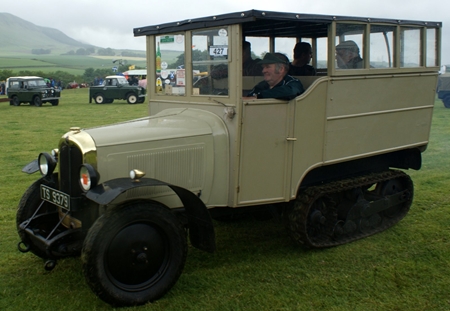You may have noticed the appearance of “double clutch” technology recently. What is this new breakthrough? DCT or PDK, both refer to dual clutch transmissions, or for Porsche it is “Porsche Dual Klutch” and hence PDK (the Germans like to be different – especially Porsche). However, like most things automotive, this ‘new’ development in transmissions is anything but new.
The man who invented the dual-clutch gearbox was Adolphe Kégresse, the automotive engineer to the Russian Royal family, who is best remembered for developing the half-track, a type of vehicle with military applications, equipped with endless rubber treads allowing it to drive off-road over various forms of terrain. That was 1902. In 1939, Kégresse conceived the idea for a dual-clutch gearbox, but unfortunately, adverse business circumstances (call it WWII if you like) prevented further development.
 Kegresse Half Track.
Kegresse Half Track.
How does DCT work? A dual-clutch transmission offers the function of two manual gearboxes in one. In a standard manual gearbox there are usually five gears and one clutch to split the transmission from the engine torque input. A dual-clutch gearbox, by contrast, uses two clutches. Instead of the left foot clutch pedal, sophisticated electronics and hydraulics control the clutches, just as they do in a standard automatic transmission. In a DCT, however, the clutches operate independently of each other. One clutch controls the odd gears (first, third, fifth and reverse), while the other controls the even gears (second, fourth and even sixth – in a six speed). Using this arrangement, gears can be changed without interrupting the power flow from the engine to the transmission. In some ways this is similar to Captain Wilson’s ENV pre-selector gearbox (remember it?), where one ratio could be selected whilst you were still in another ratio. Even reverse, though this was frowned upon.
The way DCT works is quite unusual. A two-part transmission shaft is at the heart of a DCT. Unlike a conventional manual gearbox, which houses all of its gears on a single input shaft, DCT splits up odd and even gears on two input shafts. To be able to do this, the outer shaft is hollow, making room for an inner shaft, which is nested inside. The outer hollow shaft feeds second and fourth gears, while the inner shaft feeds first, third and fifth.
With DCT, no left leg or left hand is needed and it can do upshifts in a mere 8 milliseconds, and many drivers now feel that the DCT offers the quickest acceleration times of any vehicle on the market. It certainly offers smooth acceleration by eliminating the shift shock that accompanies gearshifts in manual transmissions and even some automatics. Best of all, it affords drivers the luxury of choosing whether they prefer to control the shifting themselves or let the computer do all of the work. And in most instances, the computer knows best!
With the world’s attention on fuel economy, perhaps the most compelling advantage of a DCT is a claimed improvement in economy. Because the power flow from the engine to the transmission is not interrupted followed by a call for more fuel by the engine, fuel efficiency increases dramatically. It is claimed that a six-speed DCT can deliver up to a 10 percent increase in relative fuel efficiency when compared to a conventional five-speed automatic. That is impressive numbers!




